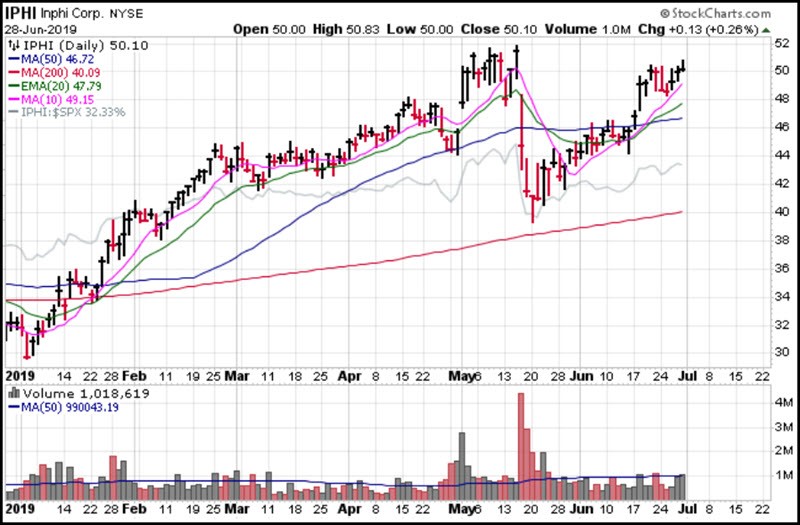

Want the latest recommendations from Zacks Investment Research? Today, you can download 7 Best Stocks for the Next 30 Days. The report is only available for a limited time. Zacks’ just-released special report reveals 8 stocks to watch.


Early investors could see gains similar to buying Microsoft in the 1990s. In the process, it’s expected to create 22 million jobs and generate $12.3 trillion in activity.Ī select few stocks could skyrocket the most as rollout accelerates for this new tech. Current technology will soon be outdated and replaced by these new devices. This means some might wait for a pullback, but who knows when that will be as the market continues to climb in 2020.īiggest Tech Breakthrough in a Generationīe among the early investors in the new type of device that experts say could impact society as much as the discovery of electricity. IPHI did touch a new 52-week high on January 17. Therefore, growth-minded investors should think about considering Inphi stock. Peeking further ahead, its adjusted earnings are projected to expand by roughly 40% on an annualized basis over the next three to five years, which easily tops AMD’s 24% and Nvidia’s 9.4%. Inphi is a Zacks Rank #1 (Strong Buy) right now, based on its positive earnings revision activity. The firm’s top-line expansion is expected to lift its adjusted fiscal 2019 earnings by 84% and an additional 32% in 2020 to hit $2.09 a share. Inphi’s fiscal 2020 sales are then expected to climb 21.2% above our current-year estimate to reach $439.6 million. Meanwhile, the company’s full-year fiscal 2019 revenues are projected to jump over 23% from $294.5 million in 2018 to $362.6 million. Our current Zacks estimates call for the firm’s adjusted Q4 earnings to come in flat from the year-ago period at $0.45 per share on the back of 15.5% sales growth. Looking ahead, the chip space is set to bounce back in 2020 in terms top and bottom line growth, as the industry continues to act as the backbone of the technological revolution. In terms of the broader semiconductor market picture, investors should note that the chip space is coming off one of its worst years since the early 2000s, with overall sales projected to fall roughly 13% in 2019, according to the Semiconductor Industry Association. The company expects the deal will “further reinforce its premier positioning in data center interconnects, expand its presence into strategic geographic regions for talent acquisition and accelerate its strategic roadmap in developing electro-optics solutions for our Cloud and telecom customers.” More recently, Inphi officially announced on January 13 that it completed its previously announced acquisition of eSilicon for $216 million in both cash and the assumption of debt. Cloud computing and telecom unit strength helped drive Inphi’s Q3 performance. The Santa Clara, California-based firm topped our third-quarter 2019 estimates in the fall, reporting record revenue and EPS in the process. Inphi’s pitch to clients and investors is straightforward: the firm helps “move big data fast, around the globe, with high quality and reliability.” Inphi makes semiconductor components and optical subsystems for networking OEMs, cloud computing and telecom companies, and more. And Inphi Corporation (IPHI), which has crushed its industry’s recent expansion, looks like a chip stock that investors might want to buy at the moment. That outlook is ahead of the $133.9 million in sales and $0.50 per share in adjusted profits that analysts are currently modeling for.Semiconductor stocks have surged over the last year and a return to sales and earnings growth appears to be in the cards for 2020. Revenue in the second quarter is expected to be in the range of $147.8 million to $152 million, which should result in adjusted net income of $33.15 million to $36.35 million, or $0.62 to $0.68 per share. On the conference call with analysts, Tamer noted that Inphi is taking a conservative approach to revenue guidance in the second quarter due to macroeconomic uncertainties. Now, we believe the significant paradigm shifts brought on by 'work from home', electronic commerce, distance learning, streaming and other remote usage activities may result in further acceleration of bandwidth upgrades. These included upgrades of data center, 5G, metro and long-haul networks to PAM and Coherent technologies, designed to increase available bandwidth. Prior to the crisis, we were already delivering on new product cycles for our cloud and telecom customers.


 0 kommentar(er)
0 kommentar(er)
